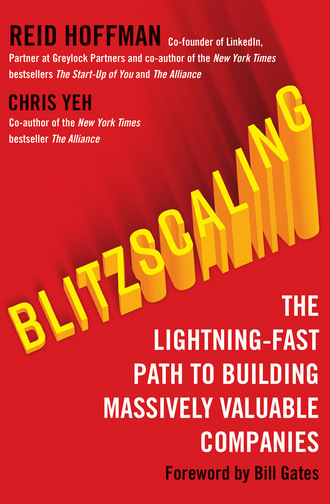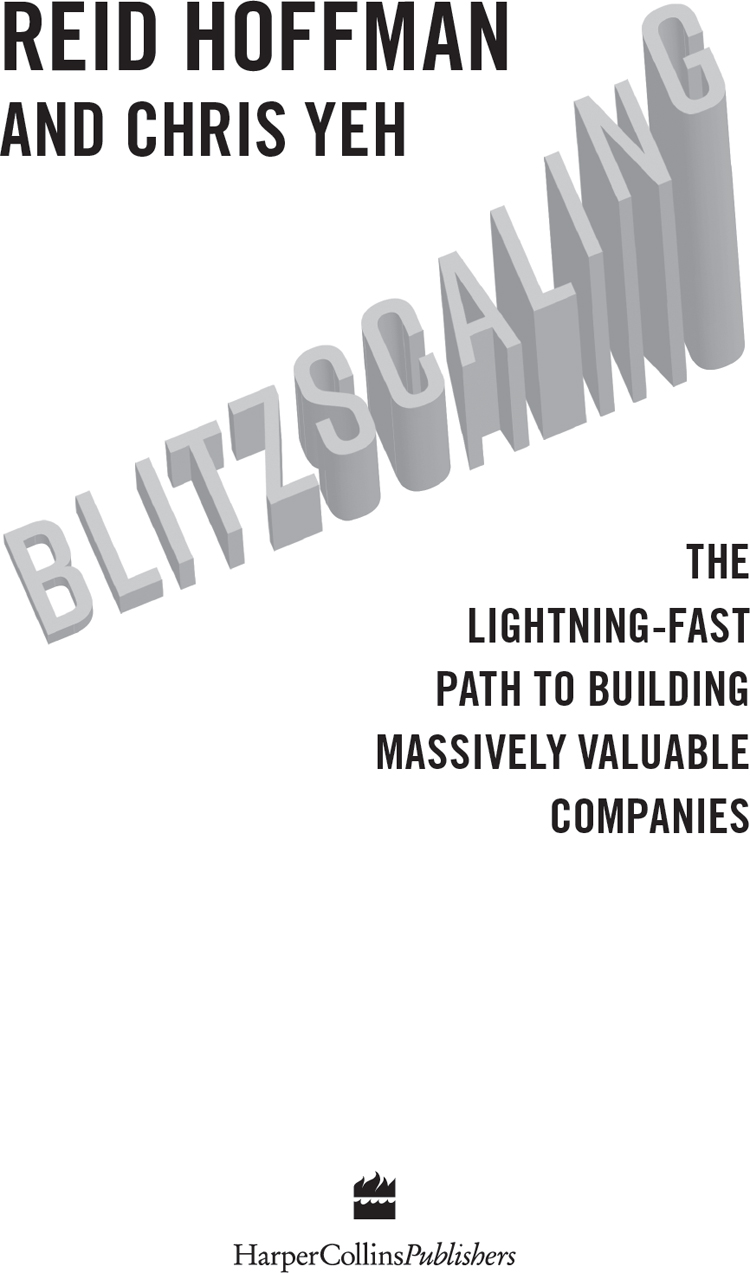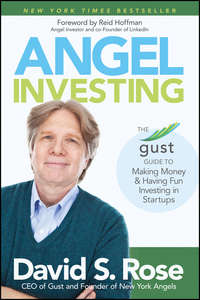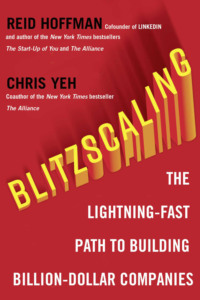
Полная версия
Blitzscaling


COPYRIGHT
HarperCollinsPublishers
1 London Bridge Street
London SE1 9GF
www.harpercollins.co.uk
First published in the US by Currency, an imprint of the Crown Publishing Group, a division of Penguin Random House LLC, New York
This UK edition published by HarperCollinsPublishers 2018
FIRST EDITION
© Reid Hoffman and Chris Yeh 2018
Cover layout design © HarperCollinsPublishers Ltd 2018
A catalogue record of this book is available from the British Library
Reid Hoffman and Chris Yeh assert the moral right to be identified as the authors of this work
All rights reserved under International and Pan-American Copyright Conventions. By payment of the required fees, you have been granted the nonexclusive, non-transferable right to access and read the text of this e-book on screen. No part of this text may be reproduced, transmitted, downloaded, decompiled, reverse engineered, or stored in or introduced into any information storage retrieval system, in any form or by any means, whether electronic or mechanical, now known or hereinafter invented, without the express written permission of HarperCollins e-books.
Find out about HarperCollins and the environment at www.harpercollins.co.uk/green
Source ISBN: 9780008303631
Ebook Edition © October 2018 ISBN: 9780008303655
Version 2018-09-10
CONTENTS
Cover
Title Page
Copyright
Foreword by Bill Gates
Introduction
Part I: What Is Blitzscaling?
Software Is Eating (and Saving) the World
The Types of Scaling
The Three Basics of Blitzscaling
The Five Stages of Blitzscaling
The Three Key Techniques of Blitzscaling
Part II: Business Model Innovation
Designing to Maximize Growth: The Four Growth Factors
Designing to Maximize Growth: The Two Growth Limiters
Proven Business Model Patterns
The Underlying Principles of Business Model Innovation
Analyzing a Few Billion-Dollar Business Models
Part III: Strategy Innovation
When Should I Start to Blitzscale?
When Should I Stop Blitzscaling?
Can I Choose Not to Blitzscale?
Blitzscaling Is Iterative
How Blitzscaling Strategy Changes in Each Stage
How the Role of the Founder Changes in Each Stage
Part IV: Management Innovation
Eight Key Transitions
Nine Counterintuitive Rules of Blitzscaling
The Never-ending Need for Change
Part V: The Broader Landscape of Blitzscaling
Blitzscaling Beyond High Tech
Blitzscaling Within a Larger Organization
Blitzscaling Beyond Business
Blitzscaling in Greater Silicon Valley
Other Blitzscaling Regions to Watch
China: The Land of Blitzscaling
Defending Against Blitzscaling
Part VI: Responsible Blitzscaling
Blitzscaling in Society
Framework for Responsible Blitzscaling
The Response Spectrum
Balancing Responsibility and Velocity as the Organization Grows
Conclusion
Acknowledgments
Appendix A: Disclosures
Appendix B: The Blitzscalers
Appendix C: CS183C Essays
List of Searchable Terms
About the Authors
Back Ad
About the Publisher
FOREWORD BY BILL GATES
I’ve known Reid Hoffman for years. Our friendship started on my visits to Silicon Valley to meet with Greylock Partners, the venture capital firm where Reid is a partner, so I could learn about the companies they were investing in. I was always impressed by his sharp mind and brilliant business sense. Reid is famous for hosting long dinners where the conversation runs late into the night, and we’ve spent many meals breaking down the technology industry, analyzing the promise of artificial intelligence, and more. When Microsoft CEO Satya Nadella started talking about acquiring LinkedIn, I knew it would be an amazing fit.
Of all the things I’ve discussed with Reid, the most thought-provoking might be blitzscaling. It is an idea that applies to many different industries, as he and Chris explain in the last section of this book. But prioritizing speed over efficiency—even in the face of uncertainty—is especially important when your business model depends on having lots of members and getting feedback from them. If you get in early and start getting that feedback and your competitors don’t, then you’re on the path to success. In any business where scale really matters, getting in early and doing it fast can make the difference.
This is especially true for two-sided business models, where you have two user groups that create positive network effects for each other. For example, LinkedIn wants to attract people who are looking for work as well as employers who want to hire them. Airbnb wants guests looking for a place to stay as well as hosts with space to rent. Uber wants to attract drivers as well as riders.
And a software company with an operating system to sell wants app developers as well as end users. Microsoft definitely went through a blitzscaling phase (although we didn’t call it that at the time). We got on the learning curve early and were able to build a reputation as a serious company. We had an extreme culture of working hard and getting things done fast.
The ideas behind blitzscaling aren’t just for startups and scale-ups. They’re important for big, established companies too. The window for action can be tiny and it can close quickly. Even a few months of hesitation can mean the difference between leading and chasing.
Reid and Chris’s ideas are more practical than ever, because it is now possible to get big fast in a way that simply wasn’t feasible a few decades ago. There is a rich ecosystem of service providers and outsourcing companies to support rapid growth. Many companies have gone through their own big growth spurts, so there are lots of examples to learn from. User feedback comes in a constant stream of data. Product cycles have dropped from yearly to weekly or daily. And good reviews can spread in an instant online, so a strong product can quickly attract a big audience.
In other words, the case studies you’re about to explore and the tools you’re about to gain have never been more relevant. This is an ideal moment to be reading this book. I’m glad Reid and Chris are sharing their insights.
Introduction
2011: SAN FRANCISCO, AIRBNB HEADQUARTERS
“They’re probably going to kill you.”
The year was 2011, and in the offices of Airbnb, then a scrappy little forty-person start-up, its cofounder and CEO Brian Chesky had just received some very bad news.
Brian pondered the implications of the ominous prediction he’d just heard from Andrew Mason, the cofounder and CEO of Groupon. He didn’t like it.
Brian and his cofounders, Joe Gebbia and Nathan Blecharcyzk, had already fought their way through plenty of obstacles to build Airbnb, a website that makes it easy for people to rent out their rooms or homes for the night. In the beginning, every investor the founders approached had turned them down or, worse, ignored them. The company was on the upswing now, but the painful early days were still fresh in their minds, and they weren’t looking for another battle.
When the Airbnb founders first met, Paul Graham, the highly regarded founder of the start-up accelerator Y Combinator (YC), told them flat out that their idea was terrible. “People are actually doing this?!” he incredulously asked. When Brian told him yes, people were, in fact, renting out their living spaces for a night, Graham’s response was “What’s wrong with them?”
Still, Graham had accepted the Airbnb guys into the three-month-long YC program. Not because he was inspired by their Airbnb business, but because he was impressed by the hustle of the founders. He loved the (now famous) story about how Chesky and his cofounders managed to pay the bills while trying to get Airbnb off the ground. It was 2008, a US presidential election year, so they created and sold special-edition cereals called “Obama O’s” and “Cap’n McCains”—a sugary parody of (or tribute to, depending on how you look at it) that year’s candidates Barack Obama and John McCain. The creativity and persistence displayed by the Airbnb founders as “cereal entrepreneurs” got them in the door at YC; once in the program, they refined their business and were able to persuade two leading venture capital firms, Sequoia Capital and Greylock Partners (where I am a general partner), to invest.
Now, nearly four years later, it seemed like all the hard work was finally starting to pay off. Having celebrated its millionth booking, Airbnb had plenty of working capital, and it was clear that the concept was valuable.
But when you’re successful, you attract competition. And sometimes that competition represents a deadly threat.
In Airbnb’s case, that threat was three brothers from Cologne, Germany: Oliver, Marc, and Alexander Samwer. They had become billionaires by analyzing successful US companies, rapidly creating copycats in Europe, and, in many cases, selling those “cloned” companies to their original American inspirations. In other cases, the Samwers actually held on to and built out their clones; Zalando, the “Zappos of Europe,” had over ten thousand employees and was worth more than $10 billion in 2017.
Their first success was Alando, an eBay knockoff that they were able to sell to eBay for $43 million, just one hundred days after launching it. The Samwer brothers then invested in the German versions of YouTube (MyVideo), Twitter (Frazr), and Facebook (StudiVZ) before founding their own start-up studio, Rocket Internet.
In early 2011, Brian and his team started noticing that Airbnb users were being spammed by a new company named Wimdu. Wimdu had apparently just received $90 million—the largest investment in a European start-up to date—from none other than Rocket Internet and Kinnevik, a major Swedish investment company that had partnered with the Samwer brothers.
The problem? Wimdu’s business model and website looked like a knockoff of Airbnb’s.
Wimdu was founded in March 2011, and, within weeks, the Berlin-based company had hired a staggering four hundred employees and opened twenty offices across Europe. Meanwhile, the original, but much smaller, Airbnb had raised only $7 million, had just forty employees, and operated out of a single office in San Francisco. As a first-time CEO, Brian wasn’t even sure what was involved in opening a second office, let alone dozens more on another continent.
Brian also knew that if Wimdu was able to capture and dominate the European market, Airbnb might not survive. “If you’re a travel site and you don’t cover Europe, you’re dead,” he told us in 2015, when he visited the Technology-Enabled Blitzscaling class we taught at Stanford University.
The Samwer brothers had named their price: Airbnb could have Wimdu in exchange for a 25-percent stake in Airbnb. Now Brian faced a difficult decision, with painful consequences regardless of what option he chose.
In response, Brian turned to one of his favorite decision-making techniques: reaching out to the world’s leading experts. His first call was to the CEO of Groupon at the time, Andrew Mason. The leading daily deals company had had a similar experience the previous year: In December 2009, the Samwer brothers had launched CityDeal, their Groupon lookalike. Six months later, Groupon paid a nine-figure price, roughly 10 percent of its valuation at that point, to acquire this competitor.
Here was the question weighing heavily on Brian and his team: Should Airbnb follow Groupon’s strategy and just buy the knockoff company? Brian’s gut instinct was to say no. Integrating Wimdu’s finance-centric and metric-driven team could harm Airbnb’s design-driven culture. He was also reluctant to reward what he saw as a legal extortion racket rather than a sincere attempt to create value in the market.
Yet Brian felt he had an obligation to consider the offer. Mason had told him that despite the many problems the CityDeal acquisition had brought, it had also accelerated Groupon’s progress into the European market, which ended up accounting for nearly 30 percent of its global sales. It could easily be argued that giving up 10 percent of Groupon for CityDeal was actually a good deal. But perhaps emboldened by their successful CityDeal gambit, the Samwers were asking for a far larger share of Airbnb—a full 25 percent.
On the other hand, Airbnb could reject the offer and instead take on the aggressive Samwer brothers in a head-to-head competition. But Wimdu had the home-turf advantage, not to mention ten times the number of employees and more than ten times the amount of invested capital. Competing against them would be one hell of an uphill battle.
Tired of the fund-raising grind, especially its emotional toll, Brian wondered whether he had it in him to take on this new and likely bruising fight. But he and his team had spent eighteen seemingly fruitless months working on Airbnb before entering Y Combinator, racking up tens of thousands of dollars in credit card debt. After all the blood, sweat, and tears, were they really willing to give up a quarter of their company?
Ultimately, Brian decided not to buy Wimdu, swayed in part by the arguments of his key advisers. Facebook founder Mark Zuckerberg counseled him to fight. “Don’t buy them,” he said. “The best product will win.”
YC’s Paul Graham gave similar feedback. “They’re mercenaries. You’re missionaries,” he told Brian. “They’re like people raising a baby they don’t actually want.”
When Brian reached out to me for my advice on the situation, I too advised him not to buy Wimdu. The key issue wasn’t the price and dilution, but the way a merger could pose impediments to speed and success. “Buying [Wimdu] adds a substantial amount of integration risk, which tripped up Groupon after buying CityDeal,” I told him. “Merging company cultures and company management could create potentially fatal risks, especially if it slows us down. With Airbnb, we have a business that is already benefiting from network effects. We can win.” I stand by that advice today.
In the end, Airbnb’s founders realized that they wanted to take on the Samwers—and they wanted to win. But how?
The key was an aggressive, all-out program of growth that we call blitzscaling. Blitzscaling drives “lightning” growth by prioritizing speed over efficiency, even in an environment of uncertainty. It’s a set of specific strategies and tactics that allowed Airbnb to beat the Samwer brothers at their own game.
Just a few months later, determined to acquire the resources needed to outscale the Samwers, Brian raised $112 million in additional venture capital. Airbnb then embarked on an aggressive international expansion plan, including the acquisition of Accoleo, a smaller and more affordable German Airbnb clone, that allowed Airbnb to compete directly with Wimdu in its home market. By the spring of 2012, Airbnb had opened nine international offices, setting up shop in London, Hamburg, Berlin, Paris, Milan, Barcelona, Copenhagen, Moscow, and São Paulo. Bookings had grown ten times since that previous February, and in June 2012 Airbnb announced its ten millionth booking.
“The Samwers gave us a gift,” Brian admitted many years later in our Blitzscaling class. “They forced us to scale faster than we ever would have.” By choosing to grow at a breakneck pace, Airbnb had achieved a dominant position in its market. Despite the initial advantages that the Berlin-based Wimdu had in human resources, financial capital, and European market knowledge, the techniques that Brian and his cofounders implemented allowed Airbnb to meet and ultimately defeat its challenger.
2010: SHENZHEN, CHINA, TENCENT HEADQUARTERS
About a year before Airbnb embarked on its blitzscaling journey, in a different CEO’s office on the other side of the world, the message that would change everything arrived in the middle of the night.
It was the fall of 2010, and Pony Ma (Chinese name: Ma Huateng) was trying to figure out what came next for Tencent, the company he had run since founding it in 1998 with four classmates from Shenzhen University. Thanks to its core product, the QQ instant messaging service, which had 650 million monthly active users, Tencent had become one of China’s most valuable Internet companies with revenues of nearly $2 billion, a market capitalization of over $33 billion, and more than ten thousand employees. However, QQ was now a mature desktop product based on late-1990s technology, and its user base had stopped growing. Its American counterpart, AOL Instant Messenger, was already in a swift decline.
Ma was convinced that Tencent had to develop a new breakthrough product for the emerging smartphone platform—or else. “Internet companies that can react will survive,” he said, “and those who can’t will die.”
The message Pony Ma read that night was from one of Tencent’s employees, Allen Zhang (Chinese name: Zhang Xiaolong), a fellow entrepreneur whose company, Foxmail, Tencent had acquired five years earlier. Zhang now ran the company’s Guangzhou R&D division, which was a two-hour drive from Tencent’s Shenzhen headquarters. He had been monitoring the rapid growth of a new social messaging product called Kik, which was especially popular among young people. He decided that Tencent needed to create its own social messenger for smartphones—and quickly.
Zhang’s proposal represented not only a huge opportunity but also a huge risk, with equally huge uncertainty about the outcome. While a new messenger service might appeal to young consumers, it was probably going to cannibalize QQ, which was, after all, Tencent’s core business. Furthermore, Tencent had partnered with leading mobile carriers like China Mobile to receive 40 percent of the SMS charges that QQ users racked up when they sent messages to mobile phones. A new service could hurt Tencent’s financial bottom line and at the same time risk its relationships with some of China’s most powerful companies.
It was the sort of decision that publicly traded, ten-thousand-person companies typically refer to a committee for further study. But Ma wasn’t a typical corporate executive. That very night, he gave Zhang the go-ahead to pursue the idea. Zhang put together a ten-person team, including seven engineers, to build and launch the new product.
In just two months, Zhang’s small team had built a mobile-first social messaging network with a clean, minimalistic design that was the polar opposite of QQ. Ma named the service Weixin, which means “micromessage” in Mandarin. Outside of China, the service became known as WeChat.
What came next was staggering. Just sixteen months after Zhang’s fateful late-night message to Ma, WeChat celebrated its one hundred millionth user. Six months after that, it had grown to two hundred million users. Four months after that, it had grown to three hundred million users.
Pony Ma’s late-night bet paid off handsomely. Tencent reported 2016 revenues of $22 billion, up 48 percent from the previous year, and up nearly 700 percent since 2010, the year before WeChat’s launch. By early 2018, Tencent reached a market capitalization of over $500 billion, making it one of the world’s most valuable companies, and WeChat was one of the most widely and intensively used services in the world.
Fast Company called WeChat “China’s app for everything,” and the Financial Times reported that more than half of its users spend over ninety minutes a day using the app. To put WeChat in an American context, it’s as if one single service combined the functions of Facebook, WhatsApp, Facebook Messenger, Venmo, Grubhub, Amazon, Uber, Apple Pay, Gmail, and even Slack into a single megaservice. You can use WeChat to do run-of-the-mill things like texting and calling people, participating in social media, and reading articles, but you can also book a taxi, buy movie tickets, make doctors’ appointments, send money to friends, play games, pay your rent, order dinner for the night, plus so much more. All from a single app on your smartphone.
Ma himself recognized the importance of the decision he had made, saying in an interview, “Looking back, those two months were a matter of life and death.”
These stories of extreme growth, whether in California or halfway around the world in China, are perfect examples of why it’s valuable to study what blitzscaling is and how it works.
Throughout this book, we will be telling the stories of various blitzscalers. Appendix B: The Blitzscalers includes brief profiles of these companies that provide more context. For even more background, visit Blitzscaling.com.
BLITZSCALING: THE SECRET WEAPON FOR BUILDING SCALE-UPS
When a start-up matures to the point where it has a killer product, a clear and sizable market, and a robust distribution channel, it has the opportunity to become a “scale-up,” which is a world-changing company that touches millions or even billions of lives. Often, the fastest and most direct path from start-up to scale-up is the hypergrowth produced by blitzscaling.
The enterprise software company Slack reached this critical stage once it was able to demonstrate the rapid and accelerating adoption of its team messaging apps by its initial market of software development teams. Nearly five years passed between the time when Slack was founded and the initial launch of its product. But once it launched, Slack users themselves drove user growth by adding many colleagues at a time, aided by a frictionless process that allowed new users to jump in with a simple Web application or by downloading a mobile app from iTunes or Google Play. After the company reached this point, it began to scale rapidly, adding employees, capital, and customers at a blistering pace. Slack had raised $17 million during the first five years of its life; within eight months of launch, it had raised another $163 million and a total of $800 million by late 2017.
Any company, whether a global giant or a start-up in a cofounder’s garage, would love to launch and grow killer businesses like Airbnb, WeChat, and Slack. Yet those who actually manage to do so, especially to the degree that Brian Chesky and Pony Ma did, are still exceedingly rare. Why is that? What sets these companies apart from the rest?





